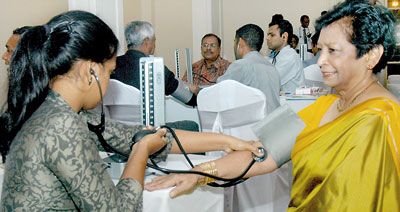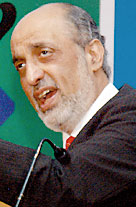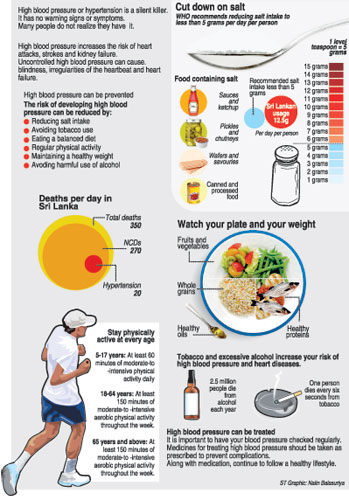News
Consume less salt and live longer, says WHO expert
View(s):By Kumudini Hettiarachchi
Try and cut out the lunu in the lunu-ambul of curries and don’t stir that spoonful of salt into the rice, is the call to all Sri Lankans from a top health expert. Stop adding salt when boiling the rice and refrain from lacing the curries with salt, stresses Dr. Firdosi Rustom Mehta, World Health Organization (WHO) Representative to Sri Lanka, adding that dried fish, chutneys, salted tiffins, sauces and processed and pre-packaged food should also be kept away from the dining table.

Invitees getting their pressure checked in the foyer of the event venue. Pix by Nilan Maligaspe
Quoting a recent study by Dr. Renuka Jayatissa of the Medical Research Institute, he said Sri Lankans are taking as much as 12.5g of salt a day when the recommendation is less than half – 5g or a level teaspoonful. The WHO Representative’s concern comes as World Health Day is celebrated today (April 7) with the theme of ‘High blood pressure’.
Urging people to “take control” not only of the salt intake but also of the silent killer that is high blood pressure, Dr. Mehta pointed out that an easy way to rein in hypertension is simply to eat less salt. This, in turn, would have an impact on the epidemic of non-communicable diseases (NCDs) which has become the scourge of current times.
On Friday, at the event held by the WHO Local Office at the Kingsbury Hotel in Colombo, to mark World Health Day the message that was driven home was the need to keep NCDs at bay. Invitees were able to get their pressure checked in the foyer, while in the hall were stalls where weight and height were checked and the Body Mass Index (BMI) calculated.
Advice on the right BMI was given gently with a table displaying what should and should not be eaten. Among the healthy and informative messages and entertainment items was also an exercise routine.

WHO represntative Dr. Firdosi Rustom Mehta addresses the audience at the event to mark World Health Day
“Sri Lanka has a cutting edge over others in the region not only to tackle but also beat NCDs,” Dr. Mehta told the Sunday Times, adding that a few more steps in the right direction and Sri Lanka can show the way to the other 10 countries in the ‘Southeast Asia Region’. The WHO has divided the world into six health regions and the Southeast Asia Region with New Delhi, India, as its base comprises Sri Lanka, India, Bangladesh, Bhutan, Nepal, Maldives, Thailand, Myanmar, Indonesia, Timor-Leste and North Korea.
Zeroing in on the specifics, Dr. Mehta points out that in Sri Lanka, 39.2% of adults over 25 years of age had raised blood pressure according to 2008 data.
The Southeast Asia Region is important as it has the largest population of 1.8 billion when taking the whole world; it has faced the largest number of natural disasters including earthquakes, tsunamis and floods; all countries in the region are on an economic trajectory; and regrettably it also has the highest disease burden of both NCDs and Communicable Diseases (CDs) NCDs — the four main ones being cardiovascular disease, diabetes, cancer and chronic respiratory disease — cause 1 in 4 (25%) of premature deaths (those under 60).
Dr. Mehta underscored the four modifiable risk factors for NCDs as tobacco use, unhealthy diet, physical inactivity and excessive consumption of alcohol. These are the main drivers fuelling the epidemic. (The other risk factors of age, sex, ethnicity and genetics cannot be changed.)
When taking stock, NCDs are creating a huge burden of suffering, disease and death, the Sunday Times learns and this is why the WHO has been addressing this major public health problem in the past decade or more.
Its efforts have borne fruit, according to the WHO Representative, with the NCD issue being taken up by the United Nations General Assembly in 2011, just the second time in the history of the UN that a health issue went before the world gathering. The other was Acquired Immunodeficiency Syndrome (AIDS).
“These are historic milestones,” says Dr. Mehta, explaining that what emerged was a request to UN member-states to prioritize the battle against NCDs, mobilizing resources from both within and without. Strategies had to be developed to fight this epidemic not only at country level but also at regional as well global levels, with a plea going out to donors and partners to support the cause.
The focus should be on preventable and modifiable risk factors, the things that can and need to be changed. But this is beyond health. It is multi-sectoral with multi-partners. The mobilization not only of the community but also of industry, the private sector and everyone is of vital importance, it is learnt.

Commending Sri Lanka for the strides made in reducing tobacco use, he said the country was the first in the region and third globally to sign the Framework Convention on Tobacco Control (FCTC). According to 2008 estimates the smoking prevalence is 21.4% for men and 0.3% for women.
“Women are not smoking, which is good,” he says, adding that levels of current smoking are not high. The need of the hour, however, is a concerted effort to stop youth getting enticed into smoking.
A positive factor is that the government is making a major effort to address tobacco-related issues by implementing pictorial warnings on cigarette packets, points out Dr. Mehta, reiterating that Sri Lanka will emerge as a leader among developing countries in this direction. Looking at the Lankan example, Thailand which has pictorial warnings covering only 60% of the packet of cigarettes is now pushing for 80%.
Going back to the theme of high blood pressure, he points out that a cost-effective, amendable way of dealing with this killer is cutting down the salt. Commending the dialogue that the Health Ministry has initiated with the food industry about reducing the salt content as well as labelling and colour-coding of food to indicate the content, Dr. Mehta said Sri Lanka could easily be the “lighthouse for the region” in showing the right way to less disease and fewer deaths due to NCDs.
Blood pressure and salt
Blood pressure is created by the beating of the heart. When the heart contracts and pushes blood through the arteries to the rest of the body, this force creates pressure on the arteries which is called systolic blood pressure. When the heart rests between beats, the pressure in the arteries is the diastolic blood pressure.
The normal systolic blood pressure is around 120 mmHg, while the normal diastolic blood pressure is around 80 mmHg.
When taking the salt (sodium) and blood pressure link, the Sunday Times learns that sodium is essential for the human body. Sodium and potassium are vital in maintaining membrane potential which keeps the integrity of the body’s cells.
The level of sodium in our bodies is usually controlled by the kidneys which, if there is too much, pass it out in the urine. However, if the sodium intake is very high, normal-functioning kidneys get overwhelmed, in the wake of which excess sodium would be left in the bloodstream.
Serious problems emerge then, for sodium attracts water. The excess sodium in the blood would then lure more water into the blood. The excess water, in turn, increases the volume of blood, resulting in the blood pressure increasing as well. This is the primary cause of high blood pressure or hypertension.
Follow @timesonlinelk
comments powered by Disqus

















